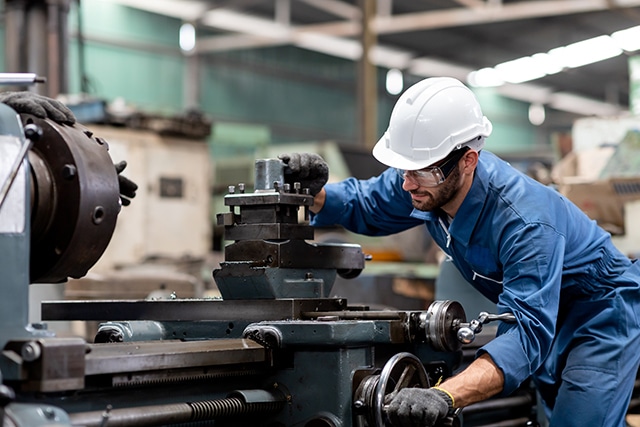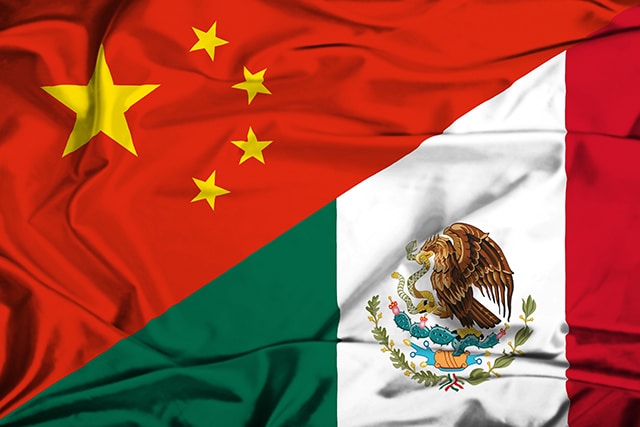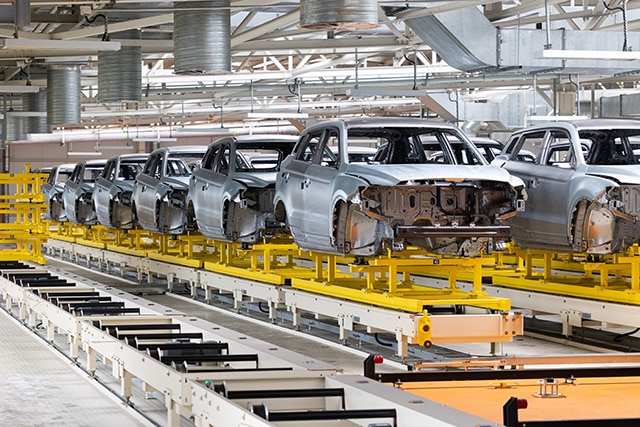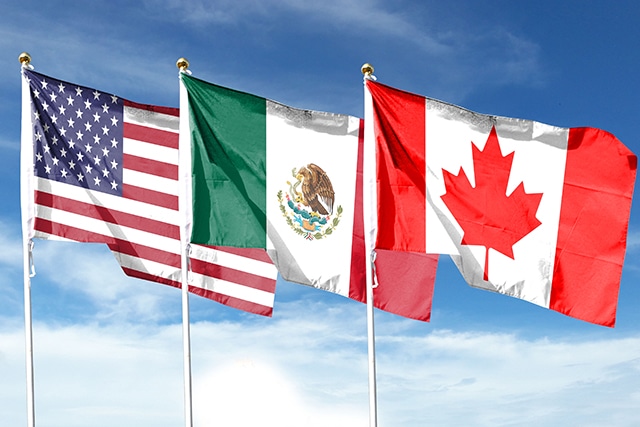 Intellectual property (IP) protection is a concern for any foreign manufacturer. With laws and trade regulations differing from country to country, it’s important to understand that what may protect you in the U.S. may not hold the same weight elsewhere. In fact, concerns regarding China’s failure to protect and enforce IP rights have been one of the key issues between the U.S and China for years.
Intellectual property (IP) protection is a concern for any foreign manufacturer. With laws and trade regulations differing from country to country, it’s important to understand that what may protect you in the U.S. may not hold the same weight elsewhere. In fact, concerns regarding China’s failure to protect and enforce IP rights have been one of the key issues between the U.S and China for years.
Conversely, IP protection for those manufacturing in Mexico has only strengthened over time, particularly with increased commitments addressed in the USMCA. It’s necessary to recognize how crucial IP is to the U.S. economy. Industries that rely on IP support roughly 45 million jobs and 38 percent of the U.S. gross domestic product. As the economy has increasingly moved towards the digital sphere, recognizing and protecting IP has only continued to grow.
In addition to the USMCA and the 11 other free trade agreements Mexico is part of, the country enforces IP protection through a number of agencies, each owning a specific responsibility when it comes to trademark, copyright, and other IP concerns. These government agencies include:
Both the oversight structure and regulations vary from what’s enforceable in the U.S., and it’s up to companies manufacturing in Mexico to understand the differences. Fortunately, a shelter provider shoulders the responsibilities of trade compliance as part of the many services it offers, allowing foreign manufacturers to stay protected when operating under Mexico’s laws.
When the United States, Mexico, and Canada agreed upon a new trade agreement, they updated regulations to meet what’s needed in today’s landscape. The USMCA recently became enforced in July 2020 and highlights several IP rights and enforcement required throughout all three countries.
Chapter 20 of the USMCA covers intellectual property rights and protection at length, highlighting areas such as copyright, trade secrets, and trademarks. It outlines the terms of each provision, specifics of how to ensure effective protection, and how long each protection period lasts. These protocols are in addition to Mexico’s separate IP protection and enforcement.
Understanding intellectual property rights in Mexico can be a complicated matter. However, with the help of an experienced shelter company like IVEMSA, you can begin to understand how different IP laws affect your operation and rest assured that you’re in compliance.
Sources:
https://www.trade.gov/knowledge-product/mexico-trade-agreements
https://www.trade.gov/country-commercial-guides/mexico-protecting-intellectual-property
Among the many advantages of nearshoring to Mexico, particularly when compared to China, is the respect for intellectual property (IP). Trade policy between the U.S. and China has been notoriously shaky over the years, due to the ongoing trade war and the risk associated with IP theft by Chinese companies. According to a 2019 CNBC CFO survey, nearly one-third of North America-based CFOs say they’ve had their IP stolen from Chinese firms at some point over the past decade.

Meanwhile, favorable trade relations between the U.S. and Mexico have been in place since NAFTA and strengthened through the newly enforced United States-Mexico-Canada Agreement (USMCA) in July 2020. The USMCA has the highest standard of any U.S. trade agreement to protect and enforce IP rights. A few of the key highlights as outlined by the Office of the United States Trade Representative (USTR) include:
Under NAFTA, many of these directives were not in place or explicitly detailed. These changes are included with new mandates regarding online piracy and IP protection within a digital environment, which is essential due to rapid innovations in technology in nearly every major manufacturing sector.
Read more: The evolution of Mexico’s intellectual property laws.
IPC president and CEO stated, “The USMCA promises to spur even greater integration among the North American economies and strengthen the region’s stature as a formidable global manufacturing base.”
According to the USTR, the top export categories from Mexico to the U.S. include machinery, electrical machinery, and vehicles. Global management consulting firm McKinsey & Company predicts automotive electronic and software market growth through 2030, increasing from $238 billion to $469 billion, with power electronics reporting an annual growth rate of 15 percent, sensor segments by 8 percent, and electronic control units by 5 percent.
An executive summary published by IBM, detailing a digital transformation in the automotive industry, highlights two key areas where digital IP protection is crucial for the future: connected vehicles and mobility services. The growing number of consumers that expect digital features, such as navigation, security, multimedia, and service diagnostics, to be part of their personal vehicles will lead to product innovation and partnerships between the automotive industry and software, telecommunications, and electronics manufacturers.
Additionally, the trend of mobility services, which provide in-vehicle innovation through smartphone connectivity and integration, which can be moved from vehicle to vehicle, are part of the operational models that guide the new products needed by the automotive industry. Fortunately, the IP protections in place under the USMCA also coincide with the rules of origin laid out in the agreement as well, which requires 75 percent of automotive content to be produced in North America.
The enforcement of the USMCA further incentivizes manufacturers to include Mexico’s nearshore services as part of their strategy. With ongoing research and development necessary to meet evolving consumer expectations, U.S. manufacturers across all sectors will continue to rely on Mexico for the cost-effectiveness and efficiency of its skilled workforce in order to fulfill their production needs during this dynamic era of growth.
As companies decide their best options for expansion, IP protection serves as another factor that pushes Mexico ahead of China in terms of trade relations with the U.S. Although the automotive industry is one of the largest sectors benefiting from the advantages of nearshoring to Mexico, it’s not the only one, since IP protection is essential to all industries, including aerospace, electronics, and medical devices, as technology is developed.
Sources:
https://ustr.gov/sites/default/files/files/Press/fs/USMCA/USMCA_IP.pdf
https://www.ipc.org/news-release/electronics-industry-joins-call-passage-usmca
https://ustr.gov/countries-regions/americas/mexico
https://www.ibm.com/downloads/cas/LVDZDXOA
https://www.trade.gov/knowledge-product/mexico-e-automotive-parts-and-supplies
 Beginning in the early-to-mid ‘90s, the Law of Industrial Property and Federal Copyright Law have covered intellectual property (IP) protection in Mexico. Additionally, U.S. manufacturers have held IP protection under NAFTA with regards to trade with Mexico. Companies will soon experience improvements to these protections through the signed and revised U.S.-Mexico-Canada Agreement or USMCA set to be enforced this year.
Beginning in the early-to-mid ‘90s, the Law of Industrial Property and Federal Copyright Law have covered intellectual property (IP) protection in Mexico. Additionally, U.S. manufacturers have held IP protection under NAFTA with regards to trade with Mexico. Companies will soon experience improvements to these protections through the signed and revised U.S.-Mexico-Canada Agreement or USMCA set to be enforced this year.
When first established, provisions of Mexico’s IP laws initially focused on property rights for inventors. These have now evolved to include the protection of patents, trademarks, trade names, trade secrets, slogans, industrial design, origin identification, and trade names with an emphasis on industrial use cases. As of 2018, Mexico issued updates to its current IP laws to offer even greater protection to businesses.
Among these changes included expanded definitions of design registration law and trademark verbiage to be inclusive of non-visual trademarks. These align with the language of the USMCA trade deal that was signed by all three countries in November of last year and revised the month following.
Entities starting the trademark registration process should expect a timeline of approximately six to eight months in order for the application to be reviewed and accepted under compliance with the country’s set regulations. Approved trademarks in Mexico are valid for ten years from the filing date and can be renewed.
IP protection laws have been modernized to include language and laws protecting digital content and trademarks. As technology and international trade relations continue to expand and evolve, the security of these protections become even more important for all industrial businesses.
When enacted, the USMCA will recognize IP enforcement protocol to include digital property to safeguard data transferred across borders. There are also standards set forth with regards to internet service provider (ISP) protections and updates to trademarks and trade secret provisions.
The revised agreement also sets a new standard for protecting the pirating of digital media, including music, books, and movies. Generally speaking, the USMCA recognizes the importance of specific IP enforcement protocols for copyright or trademark infringements as it pertains to modern classifications of provisions previously outlined.
Mexico’s ever-expanding attention to IP protection, especially in accordance with the trade agreement with the U.S. and Canada, has continued to make it a favorable choice over manufacturing in China where such IP protections do not apply. This advantage, in addition to the ongoing trade war between the U.S. and China, has caused manufacturers to consider moving or at least diversifying their operations to focus on Mexico manufacturing solutions in the near future.
With the enactment of modern laws to include digital protection, new procedures are established to ensure companies have their intellectual property safeguarded. Mexico remains steadfast in enforcing IP protection and limiting infringement through several of the country’s organizations. The Office of the General Attorney, the National Institute of Copyright, and the IMPI (Mexican Institute of Industrial Property) are all agencies that pursue disciplinary action against IP violations.
 For many businesses, their intellectual property is among their most important assets, and it is critical to protect this property, especially when nearshoring in Mexico or manufacturing in other foreign countries. National laws in Mexico are designed to enforce the protection of intellectual property and other technical or proprietary knowledge.
For many businesses, their intellectual property is among their most important assets, and it is critical to protect this property, especially when nearshoring in Mexico or manufacturing in other foreign countries. National laws in Mexico are designed to enforce the protection of intellectual property and other technical or proprietary knowledge.
NAFTA and the new USMCA dictate minimum requirements for intellectual property protection, but the US, Mexico, and Canada have their own laws that exceed these requirements. Mexico’s legal framework, for example, offers express protection for industrial secrets, heavy piracy penalties, and the ability to patent pharmaceuticals.
Here are some basic terms to know about Mexico’s intellectual property laws, as well as the steps businesses can take to protect their intellectual property when manufacturing in Mexico:
A patent can cover any invention, industrial design, or model of an invention and guarantees their exclusive use. Patents in Mexico are authorized by the Patent and Trademark Office and are granted for a set period of time.
The registry is similar to patents but applies directly to utility models or industrial designs.
Mexico’s IP laws don’t strictly define what an invention is, but they do specify things that are not considered inventions, including:
A utility model is an object, tool, device, or utensil that arises from the modification of an existing item. The new object must have more purposes or uses than the original.
An industrial design is any element that is newly created and significantly improves the way of doing any activity. Industrial designs can be drawings or models that are to scale and three-dimensional representations of the new elements.
For businesses looking to obtain patents or register their intellectual property, the process is straightforward. However, it’s important to keep records of all your documentation and be patient.
The IMPI will review all submitted materials and make a determination in about six months.
If you have questions or concerns about protecting your intellectual property in Mexico, working with a shelter provider in Mexico is a great option. Our team can answer all your questions and walk you through the steps needed to register or obtain patents so you can run your manufacturing operations in Mexico with peace of mind. Contact us today to learn more.
Reshoring manufacturing to America has been high on the list of priorities for the U.S. administration, particularly following the U.S./China trade war and COVID-19 pandemic. These two events exposed concerns regarding retaliatory tariffs and unreliable supply chains, leaving manufacturers facing extensive and costly production delays.
Furthermore, rising labor rates in China and challenges associated with intellectual property (IP) protection have also led many U.S. manufacturers to bring production closer to home. However, in many cases, this move is easier said than done.
Though the idea of reshoring manufacturing to America is a positive sentiment, research shows there are not enough qualified workers to fulfill the demand. The National Association of Manufacturers shows workforce challenges in the U.S. continue, with more than 71% of manufacturers citing an inability to attract and retain employees as their top challenge as of 2023 Q3.
Additionally, as of December 2023, the Bureau of Labor Statistics reported 601,000 open manufacturing jobs, resulting in a three-month high. Plus, predictions show the U.S. manufacturing industry could see a need for up to 3.8 million jobs over the next decade.
Therefore, in regards to labor and logistics, Mexico manufacturing makes the most viable sense for many.
The industrial labor shortage in the U.S. is due to a combination of factors. The job market is different from what it was a few decades ago. Advances in education and technology have widened job opportunities, and there aren’t as many workers who seek manufacturing as a career path, especially at the rate required to keep pace with the production necessary.
Additionally, an entire generation of industrial workers is retiring, with younger workers unwilling or unqualified to fill the vacant positions. Furthermore, manufacturing in sectors including aerospace, automotive, electronics, and medical devices is complex and requires a specific skill set and experience, which, compared to Mexico’s labor pool, U.S. workers simply don’t have.
There’s been a notable decline in America’s vocational school enrollment since 2017. Meanwhile, Mexico continues to invest in advanced education and training in the manufacturing industry, contributing to a steady pipeline of qualified workers.
Lastly, competitive pay is necessary to recruit and retain employees while managing overall manufacturing costs. Compared to labor rates in Mexico, which start at $6.96 USD for fully burdened, semi-skilled workers, U.S. manufacturers can’t compete and recruit in the same way.
Mexico manufacturing provides an alternative solution for U.S. companies that want to bring production closer to home. The proximity of Mexico to the U.S. market makes it an ideal location, leading to quicker lead times compared to China, plus incentivized trade as part of the USMCA trade bloc.
But perhaps most importantly, there’s access to a highly skilled, cost-competitive industrial workforce that can boost manufacturers’ long-term strategies.
There are several advantages of nearshoring to Mexico, and a shelter services company handles the administrative responsibilities required to set up production, including recruiting, payroll, and retention.
To discuss labor rates in Mexico and get an idea of total costs for your company, contact IVEMSA today.
Sources:
https://nam.org/wp-content/uploads/2024/01/Outlook-Survey-December-2023-Q4.pdf
China manufacturing has been the model U.S. companies have relied on for decades to save on production costs amid rising demand. However, with continuing trade policy uncertainties and the supply chain slowdown during the COVID-19 pandemic, this strategy hasn’t quite rebounded as the go-to option it once was.
While China manufacturing still makes sense for some, the shift toward manufacturing in Mexico has become a bigger part of the conversation. Fortunately, for many, there doesn’t have to be a definitive decision of choosing one location over the other. Manufacturers have seen the value of diversifying production and embracing the advantages both solutions provide.
However, let’s take a closer look at reasons why manufacturers are transitioning manufacturing to Mexico, either as an alternative to China or as an addition, and how a shelter services company can help make the move more seamless.
Tariffs have taken center stage regarding the state of manufacturing. Though nothing is certain when it comes to changes in policy, having a diverse portfolio gives manufacturers more options when there’s disruption in the market.
This was made clear during pandemic times as breakdowns in the supply chain and increasing transportation and labor costs caused manufacturers to rethink their overreliance on China. However, rather than impulsively pull away from production altogether, many have chosen to expand their manufacturing efforts and explore solutions in Mexico.
Mexico has long been a main manufacturing hub. Global companies in the automotive, aerospace, electronics, and medical devices sectors, in particular, have benefited from the close proximity to the U.S. market, a highly skilled labor pool, and the unique advantage of shelter services to meet their growing needs.
For many, the low cost of labor in China has been the biggest incentive for offshore production in previous years. However, between China’s increasing labor rates and costly transportation expenses, nearshoring to Mexico saves manufacturers both time and money.
Additionally, the geographical difference plays a key role in strategy. The proximity of Mexico to the U.S. market makes it an invaluable option, helping manufacturers cut down on lead times, increase transportation options, and gain greater production oversight for business leaders.
Manufacturing has also become increasingly complex as new technology is introduced. Therefore, company leaders are more hesitant to hand over their entire process via contract manufacturing in China. It leaves companies susceptible to intellectual property (IP) infringements and quality assurance challenges.
Alternatively, shelter manufacturing is the safest way to conduct business in Mexico. It allows companies to maintain full control over production and processes as well as ownership over IP, equipment, and materials. Moreover, working with a shelter services company minimizes risk when launching production in a foreign country and optimizes cost savings with a shorter setup time.
Rather than choosing one location over another, exploring more than one option, including manufacturing in Mexico, is where many companies see a viable long-term strategy.
If diversifying your portfolio is part of your production goals, contact IVEMSA to learn how shelter services can serve as a competitive advantage.
The more things change, the more things stay the same – at least when it comes to trade. Though manufacturers are no strangers to navigating the ups and downs of the market, there have already been unrelenting tariff applications (and retractions) in the first six months of 2025.
Yet, the one thing that has remained in place since its onset in 2018 is the trade war between the U.S. and China. This conflict first began during President Trump’s first term in office, and the volatility between the two countries has continued ever since, causing manufacturers to move away from China as a long-term strategy.
This is a significant shift following decades of American companies depending on Chinese manufacturing for its low-cost labor and steady supply chains. However, due to rising tariffs and the derailment of the supply chain infrastructure during the pandemic, manufacturers have begun to lean more heavily on nearshoring to Mexico.
In addition to the need to diversify their portfolios, the official enactment of the U.S.-Mexico-Canada Agreement (USMCA) in 2020 solidified manufacturing in Mexico as the go-to, long-term strategic move.
As a replacement to the pre-existing North American Free Trade Agreement (NAFTA), the tariff-friendly USMCA benefits those within the North American trade bloc and has resulted in a steady increase in U.S. manufacturers moving their operations away from China or at least expanding their presence by also launching production closer to home.
The focus on tariffs has kept manufacturers on their toes as the Trump administration goes back and forth with implementation, though there has been some solace found through the USMCA.
The USMCA eliminates tariffs on qualifying goods for manufacturers in the U.S., Mexico, and Canada. Whereas, there have been additional restrictions on certain components, including semiconductors and automotive parts from China, under President Trump. Add in the ongoing geopolitical tensions and skepticism around technology protection, and many manufacturers are moving away from China as their main hub of manufacturing.
Furthermore, the cheap labor rate China was once known for is steadily increasing and failing to offset Asia’s lengthy and costly shipping timeline, which can take weeks to reach the U.S., compared to a few days, if not same-day, when shipping from Mexico. Thanks to the tariff relief, streamlined customs processes, and enhanced intellectual property protection under the USMCA, manufacturing in Mexico has become a more cost-effective and reliable way to do business for many.
And by working with a shelter services company, U.S. and other foreign manufacturers have expertise on their side to stay current on trade compliance, along with the infrastructure to streamline production setup and save on manufacturing costs.
As part of a comprehensive solution, an experienced shelter services company like IVEMSA can help U.S. manufacturers navigate changes concerning trade and confirm whether their goods qualify under the USMCA.
They can also provide guidance on how to make the type of transformation necessary to meet the rules of origin to avoid the implementation of tariffs. Even in uncertain times, a shelter company can help manufacturers feel confident about their next move.
Questions about tariffs when manufacturing in Mexico? Contact IVEMSA and speak with one of our team members today.
Changes continue to affect manufacturing in Mexico, though the anticipated update regarding Mexico’s IMMEX program may be a welcome one.
In the mid-1960s, the Mexican government created what was then known as the maquiladora program as an incentive to increase foreign direct investment. Approval into the program allows U.S. and other foreign companies to temporarily import goods, materials, and equipment necessary for the manufacturing process without having to pay the 16% value-added tax (VAT), as long as the goods are exported within the required amount of time.
Currently, the government is updating the rules for application, which is intended to make the process quicker and easier to obtain certification. As of now, it can take new entities weeks or even months to be approved and receive the VAT exemption.

While the new ruling has yet to be released, industry experts expect the changes to be rolled out any day. However, because of the overhaul to the IMMEX program, applications and challenges to decisions already in process have been delayed.
Therefore, now more than ever, it’s important to understand the benefits of enlisting the help of a shelter services company, even if you’ve operated in Mexico before.
One of the many advantages of working with a shelter services company is that manufacturers have quicker access to all the necessary licenses and permits needed to operate, including IMMEX program approval and VAT certification.
Exemption from the 16% VAT goes into effect as soon as the extension request of the shelter IMMEX program is approved, representing a significant manufacturing cost savings. Additionally, a shelter services company allows manufacturers to:
Operating under a shelter company is the safest way to manufacture in Mexico. It protects foreign companies from legal exposure and provides a built-in team of trade compliance experts to prepare for and abide by the changing rules regarding tariffs and duties.
Partnering with a shelter company also allows manufacturers to save on administrative and management labor and infrastructure, including HR, accounting, payroll, and daily trade operations. Plus, having the guidance of experienced industry experts helps to reduce the learning curve associated with navigating trade laws and compliance in a foreign country.
Some manufacturers prefer to set up a standalone entity when manufacturing in Mexico. However, most seek the support of a shelter company because of the personnel and processes already in place.
From site selection to recruiting employees, a shelter company handles all of the administrative tasks necessary to get operations up and running in nearly half the time it takes a standalone entity. Furthermore, manufacturers working under a shelter still maintain full control over their production, processes, and intellectual property.
The IMMEX program has benefited U.S. and other foreign manufacturers for decades, and working with a shelter services company like IVEMSA makes obtaining permits and certifications a seamless process, regardless of what changes are in store.
Whether you decide to set up your own entity or want to take advantage of the full scope of services offered, IVEMSA can support your needs every step of the way.
For more information about the IMMEX process or to inquire about manufacturing in Mexico, contact our team today.
U.S. manufacturers have the unique benefit of working with Mexico shelter companies to create a seamless transition when launching production in Mexico for the first time.

Though there are always initial questions to evaluate the best business route, recent tariff talk has led to more questions regarding compliance. Manufacturers are particularly interested in whether their products will be deemed USMCA compliant.
Since Mexico is part of the USMCA, qualified goods under this trade agreement can be imported into the U.S. with 0% tariffs, as per the April update from the U.S. administration. However, to meet these qualifications, manufacturers must correctly categorize their products and be ready and willing to make adjustments in accordance with the Harmonized Tariff Schedule (HTS).
This process takes time, research, and customs expertise to complete correctly. It is one of the many ways Mexico shelter companies have helped U.S. and other foreign manufacturers reach their production goals in a cost-effective, timely manner.
To spearhead a strong start, here are the steps taken to ensure a successful setup:
In the early stages, a shelter company will ask qualifying questions to provide options that best align with a manufacturer’s specific growth goals. These include:
All of this helps to determine whether it’s best to create a standalone entity, implement shelter services, or a combination of both.
To ensure USMCA compliance, the customs process requires a bill of materials complete with a description of each product being imported plus pictures categorizing components to determine duty pricing.
A shelter company evaluates this with a U.S. customs broker, who determines if products qualify under USMCA compliance or if they need to be changed in any way. These details are important when calculating costs and for staying on schedule for setup.
Additionally, Mexico shelter companies further streamline the setup process by establishing industrial leases, connecting utilities, and handling all administrative responsibilities necessary for production to begin. This includes taxes and accounting, human resources and recruiting, as well as local government and legal compliance.
By delegating these tasks to a shelter company, it alleviates time and stress for manufacturers, allowing them to fully focus on production. Furthermore, manufacturers maintain complete ownership and control over their production, processes, and intellectual property.
Setting up production in a foreign country is a complex process. It’s beneficial to have local experts who understand everything needed to launch production quickly and efficiently. Working with a Mexico shelter company reduces setup time from six to seven months to three to four.
However, since not every manufacturer is an ideal fit for the shelter services model, IVEMSA evaluates all options and makes recommendations based on each company’s unique goals. This encourages a strong partnership from the beginning and sets the foundation for manufacturers to be successful.
Navigating change is always challenging as there’s a level of uncertainty that comes with it. However, there are also core foundations to rely on that make it easier to adapt.
Right now the lack of clarity on proposed tariffs on Mexico is hi gh on the list of challenges some manufacturers expect to face. Though, even as a new U.S. presidential administration is officially in place, it remains to be seen if and when certain campaign promises will come to fruition.
gh on the list of challenges some manufacturers expect to face. Though, even as a new U.S. presidential administration is officially in place, it remains to be seen if and when certain campaign promises will come to fruition.
Economists have already pointed out the contradictions of President Trump’s campaign promise of “100% tariff(s) on every single car coming across the Mexican border” in an effort to boost both U.S. revenue and U.S. manufacturing.
While tariffs do bring in some revenue as it’s a tax American importers pay for goods from other countries, they also make the production of foreign cars more expensive, which means fewer Americans will buy them, causing tariff revenue to go down.
However, as of Inauguration Day in the U.S., President Trump has already decided to hold off on imposing tariffs for the time being but plans to issue an executive order to begin studying trade issues with countries including China, Canada, and Mexico.
As predicted, there’s been back-and-forth uncertainty as a result of the Trump administration’s indecision about implementing tariffs and which countries are to be affected. Changes have been fast and furious with a brief timeline of the first 60+ days as follows:
January 20 – The Trump administration did an about-face on its previous decision to hold off on imposing tariffs and announced the implementation of 25 percent tariffs on Canadian and Mexican imports starting on February 1.
January 26 – Doubling down, Trump also announced via social media his intent to impose 25% tariffs on all Colombian goods as well, promising to raise them to 50% within one week. However, these never came to fruition, and both Colombia’s president and Trump eventually rescinded their previous tariff threats.
February 1 – The Trump administration returned to its inauguration announcement and signed an executive order to impose the 25 percent tariffs on Canada and Mexico, and a 10 percent tariff on China. All countries involved discussed retaliatory tariffs before Trump agreed to a 30-day holding period for tariffs on Mexico and Canada only.
March 4 – Trump implemented tariffs on imports from China, Mexico, and Canada, the three largest trading partners of the U.S. Canada’s Prime Minister responded with the country’s own 25% tariffs on $155 billion of American goods.
Further into March, Trump began to receive pushback from U.S. automakers and ended up pausing tariffs on cars imported into the U.S. from Mexico and Canada. And, as of March 6, many of the tariffs he initiated only days before had been suspended but with promises of future tariffs on specific materials and a new focus on tariffs on the European Union.
To date, Mexico is acting in good faith and cooperating with what has been requested by the U.S. administration. Also, as of now, it seems protections under the USMCA are covered, which accounts for many of the major manufacturing sectors in Mexico, namely automotive.
However, the see-sawing shifts have been non-stop, and there’s always a chance there will be other changes, including new tariffs on the horizon.
Regardless, having seen this administration in office before, several positives remain as this potential tariff problem lingers overhead, including the solid infrastructure of Mexico shelter services to keep global production moving forward.
Though the Trump administration has stated its desire to bring manufacturing jobs back to the U.S., the reality is there are already open positions that are largely going unfulfilled. The National Association of Manufacturers reported a manufacturing skills gap could result in over two million unfulfilled industrial jobs by 2030.
Additionally, there is a struggle among a majority of U.S. manufacturers to attract and retain the talent necessary to maintain production. In this regard, the advantages of nearshoring to Mexico haven’t changed. Mexico continues to invest in higher education and training programs to generate a steady stream of manufacturing professionals across all job levels.
The cost-effective, qualified industrial labor in Mexico is one of the top reasons why U.S. and other foreign manufacturers continue to keep nearshoring as part of their overall growth strategy.
In 2018, when Trump’s administration imposed 25% tariffs on China, shelter companies in Mexico benefited and expanded their production, eventually making Mexico America’s number one trading partner.
The potential for aggressively taxed import products from Mexico to the U.S. doesn’t negate the significant economic advantage trade between these two countries provides. Most U.S. (and other foreign) manufacturers need production plants in Mexico as their products and technology continue to expand.
The high cost of doing business in the U.S. combined with the lack of industrial workers do not make for favorable conditions, especially compared to manufacturing in Mexico. Due to the cost-effectiveness, U.S. manufacturers will continue to import products, though imposed tariffs may determine which country the U.S. does business with.
Mexico remains a top-tier option as part of the North American trade bloc, its close proximity to the U.S. audience, and a proven global impact on trade for the past several decades.
There is growth within the North American semiconductor industry due to the increasing demand in the automotive and consumer electronics sectors. To prevent data access, global automakers have been instructed not to use Chinese hardware or software in new cars.
The finalized rule from the U.S. Department of Commerce’s Bureau of Industry and Security (BIS), which was first proposed in September 2024, prohibits “certain transactions involving the sale or import of connected vehicles integrating specific pieces of hardware and software, or those components sold separately, with a sufficient nexus to the People’s Republic of China (PRC) or Russia.”
The BIS rule particularly focuses on hardware and software integrated into the Vehicle Connectivity System (VCS) and software integrated into the Automated Driving System (ADS). These critical systems allow for external connectivity and autonomous driving capabilities in vehicles that are connected.
The purpose of this ruling is to deny malicious access to systems that could allow adversaries access and collection of sensitive data and the ability to manipulate cars remotely on American roads. The rule is in effect for Model Year 2027 for passenger vehicles (defined as those under 10,001 pounds) and “requires certain importers and manufacturers to submit annual Declarations of Conformity to certify their compliance with the prohibitions.”
The trade agreement between the U.S., Mexico, and Canada (USMCA) is set for review in 2026 to evaluate how it’s working. Though no major modifications are expected, specific provisions including original content rule, and repercussions against intellectual property violations, promote and protect trade within this trade bloc.
Per the USMCA, at least 75% of automobile content must be made in North America to qualify for duty-free trade. While U.S. manufacturers would appreciate the opportunity to create this content fully in America, the feasibility is simply not possible. It’s the main reason why international trade, specifically nearshoring manufacturing to Mexico, has been so prolific in the rise of global expansion for automakers, as well as other sectors.
U.S. companies leverage the manufacturing advantage in Mexico while maintaining research and development at their headquarters. Maintaining cost-effectiveness and supply chain efficiency in this way is essential, as it’s too expensive to handle the demand solely in the U.S.
To counteract any challenges on the horizon, Mexico is taking steps to stay in good standing with the U.S. as its main trading partner. During this in-between time, there is an opportunity for Mexico manufacturing for those who aren’t taking a wait-and-see approach as the U.S. administration decides next steps.
U.S. and other foreign manufacturing companies that take action now will have access to greater building availability, more favorable lease rates and terms, as well as the first pick for skilled employees.
Furthermore, implementing the solid infrastructure and flexibility of Mexico shelter services is the most viable way for U.S. and other foreign manufacturers to expand production. This has been a successful business model for decades and greatly benefits global economies, including the U.S.
As the months go on, the demand will grow as more manufacturers commit to their nearshoring plans, which will lead to more expensive industrial real estate and less opportunity to find the best talent in the desired location.
The numerous benefits of Mexico shelter services for U.S. and foreign manufacturers hold steady amidst change. These include:
Though there have been strong statements given by America’s current administration, the actions carried out may not be as heavy-hitting.
Either way, IVEMSA is keeping a close watch on any changes and continues to be a resource for clients as they adapt and grow the industry’s inevitable challenges.
For more information about the advantages Mexico shelter services offer, contact our team today.
Sources:
https://www.npr.org/2025/01/19/g-s1-43062/trump-tariffs-revenue
https://www.nytimes.com/2025/01/20/us/politics/trump-tariffs-executive-order.html
https://www.ft.com/content/f83f30be-d673-4f00-b9e5-9e9293512010
https://www.globaltimes.cn/page/202501/1326662.shtml
https://www.nytimes.com/2025/03/13/business/economy/trump-tariff-timeline.html
https://nam.org/2-1-million-manufacturing-jobs-could-go-unfilled-by-2030-13743/
Free trade agreements (FTAs) connect manufacturers on a global scale by reducing trade barriers among countries to strengthen production. Mexico has maintained a strong manufacturing presence, upholding 13 FTAs with 50 countries, including the European Free Trade Area, the Comprehensive and Progress Agreement for Trans-Pacific Partnership, and the United States-Mexico-Canada Agreement (USMCA), formerly known as the North American Free Trade Agreement (NAFTA).
Mexico has more FTAs than any other country, which has facilitated economic gains and innovation across various manufacturing sectors around the world. The USMSCA encourages foreign direct investment in Mexico’s manufacturing industry, specifically, and since its enactment, Mexico has become the top trading partner of the U.S. with nearly $798 billion in goods and services exchanged between the two countries.
Each FTA lays out specific terms regarding agreed-upon benefits and requirements. The USMCA focuses on furthering the manufacturing activity within North America’s trade bloc. And, as more U.S. companies consider nearshoring to Mexico, it’s valuable to reassess the benefits the USMCA provides.
For years, the United States, Mexico, and Canada operated under NAFTA before the USMCA officially replaced it in 2020. This enactment was intended to strengthen reciprocal trade practices across North America by including provisions relevant to modern production needs, such as digital trade and intellectual property (IP).
For instance, the trade agreement solidifies commitments to enforce penalties for IP violations to protect manufacturers from patent and copyright infringements. Another key provision of the USMCA is the Rule of Origin.
This requires that 75% of automotive content must be made in North America to qualify for tariff benefits. Per the Office of the United States Trade Representative, this rule:
Furthermore, the USMCA contains a provision regarding labor value and protection. Trade rules require 40-45% of auto content be made by workers earning at least $16 per hour. These rules are intended to encourage more investment by auto companies in research and development in the region.
Also, The Rapid Response Labor Mechanism, an agreement between Mexico and the U.S. only, allows “enforcement actions against individual factories if they fail to comply with domestic freedom of association and collective bargaining laws.”
Though much of what was originally included in NAFTA is still part of the USMCA, there are updates that have created more balanced trade and support the growth of North American economies.
Trade compliance is challenging to navigate when manufacturing in any foreign country. The smallest misstep can result in fines, project delays, or other penalties. To maintain compliance amidst changing FTA regulations, working with a Mexico shelter company helps to minimize risk and liability.
The shelter model protects U.S. and other foreign manufacturers from being legally exposed to Mexico’s authorities. It also maintains the proper permits and certifications to comply with local laws and regulations.
If you’re considering manufacturing in Mexico as a strategy in the coming year, contact IVEMSA to discuss how our shelter services can make the transition seamless.
Sources:
https://www.trade.gov/country-commercial-guides/mexico-trade-agreements
https://www.dol.gov/agencies/ilab/our-work/trade/labor-rights-usmca
https://ustr.gov/sites/default/files/files/agreements/FTA/USMCA/Text/31-Dispute-Settlement.pdf
https://ustr.gov/trade-agreements/free-trade-agreements/united-states-mexico-canada-agreement
The manufacturing industry has had its fair share of ups and downs in recent years, yet the IMMEX program in Mexico has remained relatively steady. Though there are always changes to anticipate, trends are forecasting a positive outlook heading into 2025.
Let’s explore more of what U.S. and other foreign manufacturers can expect when it comes to costs and competition in Mexico.
For manufacturing companies considering expanding to Mexico, costs remain competitive compared to the U.S. and China. And, despite changes in government leadership, the landscape looks stable to move operations.
With average inflation, any adjustments are expected to be similar to those experienced in 2024. Plus, certain cost-saving advantages remain in place, such as the proximity of Mexico to the U.S. audience and the free trade agreements Mexico holds with other countries, particularly the USMCA.
In terms of the flow of commercial trade, infrastructure can always be improved. However, there are tens of thousands of truck crossings and hundreds of millions in bilateral trade every day between the U.S. and Mexico.
Customs are well-integrated to ensure as much efficiency as possible, and this shouldn’t change anytime soon. Furthermore, with established transportation routes and advanced warehouse production, manufacturing in Mexico will continue to be the best cost-competitive solution for the North American market.
Though this year was not as dynamic as 2022 or 2023, the construction of new commercial buildings in Mexico continued strong, and more space became available than in recent years. With the expansion of available facilities, manufacturers will find it easier to negotiate leases and keep costs close to what they were in 2024.
One of the most dependable benefits of manufacturing in Mexico is the availability of a technically skilled workforce with thousands graduating every year from universities and/or technical schools. This year, the unemployment rate has been on the lower end, making room for many job opportunities, which makes recruiting top talent increasingly competitive.
Therefore, U.S. and other foreign manufacturers must establish a strong recruiting process and re-evaluate benefits to fit what is expected by talent in Mexico. These include traditional healthcare and retirement savings benefits, in addition to food coupons and transportation to work, as well as bonuses for punctuality and attendance, and paid vacations (separate from paid time off), as part of a robust compensation package.
Historically, manufacturing in Mexico has always been a cost-effective strategy for U.S. and other foreign manufacturers to expand production. There are two options to get started: establishing a standalone entity or enlisting the experienced support of a shelter company.
Working under a Mexico shelter company is the safest and most efficient way to do business. Plus, it frees up time for manufacturers to fully focus on production while maintaining complete control over all processes and intellectual property rights.
A shelter company also simplifies the transition to manufacturing in Mexico by handling all the administrative responsibilities necessary for setup. This includes site selection, recruiting and hiring employees, managing taxes and accounting, and overseeing trade compliance.
Thinking of diversifying your portfolio to include Mexico in 2025? Contact IVEMSA to discuss how our shelter services can best align with your manufacturing goals.
Source:
https://opendata.sandag.org/stories/s/Border-Crossing-and-Trade/adfp-wjae/